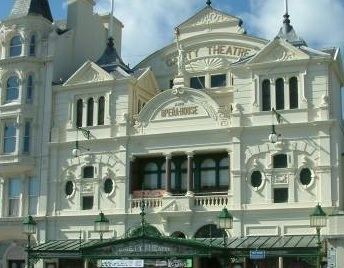Capacity 898 seated Phone +44 1624 694500 | Opened 16 July 1900 | |
 | ||
Current use Fully operational theatre with a year-round programme of shows Rebuilt 1976 Victor Glasstone (major restoration) Owner Department of Tourism and Leisure Similar Villa Marina - Isle of Man, Manx Museum, Gaiety Theatre - Dublin, Peel Castle, House of Manannan Profiles | ||
Gaiety theatre isle of man
The Gaiety Theatre is a theatre in Douglas, Isle of Man which together with the Villa Marina forms the Villa-Gaiety complex. The Gaiety is situated on Douglas promenade, overlooking the sea and adjacent to the Villa Gardens, Arcade and Colonnade.
Contents
- Gaiety theatre isle of man
- The Pavilion
- Gaiety Theatre
- Restoration
- Current use
- Friends of the Gaiety
- References
Built in 1899 to the designs of architect Frank Matcham as an opera house and theatre the Gaiety, along with the nearby Villa Marina, stands on the site of a lodge occupied in the early 19th Century by Castle Mona architect and Atholl family retainer George Steuart, and then later bought by benefactor Henry Bloom Noble and donated for recreational use.
The Pavilion
The Pavilion had been built in 1893 at the height of the Island's tourism boom and was owned by Richard Maltby Broadbent, the man who turned Groudle Glen into pleasure gardens and was instrumental in the construction of the Groudle Glen Railway.
The idea was that the Pavilion would match the theatres and dance halls at other resorts such as Blackpool. To create the space needed a "Belfast Roof" was built, meaning a barrel vaulted roof was formed from iron sections bolted together into hoops which were then reinforced and faced with laminated wood. However the venture was not a success, and the Pavilion closed after only six seasons following which Boradbent sold the land to the Palace and Derby Castle Company.
Gaiety Theatre
The new owners enlisted the services of Frank Matcham in order to carry out an extensive renovation of the venue with Matcham presenting his plans for the theatre to Douglas Corporation in March, 1899. Part of the plans saw the creation of a glass ceiling in order to afford maximum light together with an elegant and playful interior inside the narrow shell of the Pavilion's Belfast Roof and the remains of the Villa house.
The stage was extended by 42 ft (12.8 m) and the resulting loss of seating was made up for by enlarging the circle and adding the third level. The under-stage machinery was installed by the Douglas firm of J.L. Killip & Collister of Tynwald Street.
The new entrance facade, with its upstairs loggia, pedimented towers and flamboyant stucco decoration, took its inspiration from the buildings of the Italian Renaissance, while the interior, with its ceiling paintings and ornate plasterwork, combined Baroque and Elizabethan elements. An ingenious feature also found in Matcham's theatre in Buxton, Derbyshire, was what was known as a "sunburner". This consisted of a main roof air vent about a large circular glass window in which there was originally a gaslight. As the window heated up, it caused the air around it to rise and then fresh air would rush in through vents to replace it.
The theatre opened on 16 July 1900 with a West End production of "The Telephone Girl" featuring Ada Blanche. The theatre enjoyed considerable success in the Edwardian era until the outbreak of the First World War in 1914, but then much harder times set in after the war and the theatre fell into decline along with the Island's tourist industry.
Various attempts were made to regain its former commercial success, including installation of cinema equipment in the 1920s and a 1938 ice show.
The Second World War period and aftermath saw deterioration of the building outside the means of the owners to repair and by 1970 the theatre came "just one signature away" from being demolished. In 1971 the Isle of Man Government acquired the dilapidated building from the Palace and Derby Castle Company for the sum of £41,000. It also granted a further £9,000 for essential repairs, as the circle bar, toilets and stage all needed a revamp.
Restoration
In 1976 the restoration began under the direction of architect and theatre expert, Victor Glasstone. The theatre underwent further restoration from the 1990s to replicate its 1900 opening condition in time for the centenary celebration in 2000. Exactly 100 years after opening, on 16 July 2000, the centenary was celebrated with a performance of "The Telephone Girl" which opened the Gaiety in 1900 and following which was a performance of "The Corsican Brothers," a popular play which in Victorian times and a special 'Corsican Trap' was constructed for the performance. It is believed to be the only working Corsican Trap in the World. Another unique feature of the theatre is the working Act Drop depicting a dancing lady.
Current use
Today the theatre continues with productions by local companies and touring productions of musicals, drama and opera. It now forms a part of the Villa-Gaiety complex together with the Villa Marina, a nearby 1,500 seat auditorium.
The Gaiety Theatre featured on Isle of Man commemorative stamps in 1987, 1994 and 2000. In February 2008, The Gaiety hosted a Hollywood movie Me and Orson Welles, starring Zac Efron, Christian McKay and Claire Danes. The Gaiety replicates the Mercury Theatre in New York in 1937.
In November 2013 "Glee Live On Stage" was produced at the Gaiety with an all professional cast. The cast included Wayne Rodgers, Jodie-Lee Wilde, Jarred Page, Kimberley Ensor, Clark Devlin, Jordan Fox, Ruth Morrison, Rachael McCormick, Ellena Leigh, Adam Shorey, Wesley Dow & Leah Shears. Every night a different school choir from around the Island was brought on stage to sing selected songs with the cast.
Friends of the Gaiety
In 1978 the organisation Friends of the Gaiety was formed to help attract larger audiences to the theatre as well as undertaking fundraising.
